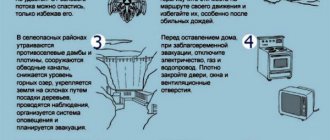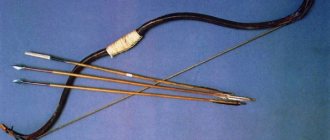Why is it better to ask for help?
If possible, go to the doctor as soon as you see a tick attached to your body. The doctor will not only remove the parasite and treat the skin, but will also immediately send it for analysis.
Tatyana Loshkareva
Honored Doctor of the Russian Federation, infectious disease doctor of the highest qualification category at the Medical Center.
You can get help at the nearest emergency room. Go there immediately. If you don’t know where it is or how to get there, dial the ambulance number - 103, they will give you the address.
Keep in mind that the likelihood of contracting tick-borne encephalitis and borreliosis depends on the duration of contact with the parasite. Therefore, you need to remove it very quickly!
If you cannot see a doctor, remove the bloodsucker yourself.
Methods for removing ticks
There are reliable, time-tested methods for removing ticks at home. The main rule is to take your time and strictly follow all recommendations. Do not neglect cleanliness: be sure to wash your hands, use clean tools and, slowly, pull out the bloodsucker. Then the removal of the blood sucker from the body will be successful.
Pincer twister
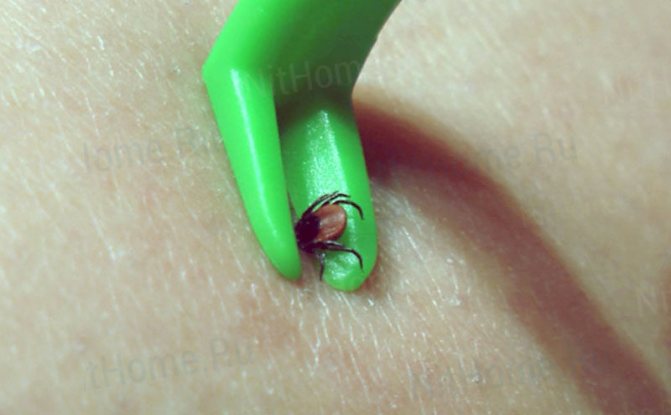
Special remover hooks help you safely remove these pests. The use of such devices minimizes possible risks: there is no compression of the bloodsucker’s body.
The device looks like a small hook, reminiscent of a nail puller. They are sold at any pharmacy.
Steps on how to properly remove a tick using such a simple device at home:
- Select the desired size of twister;
- Grab the bloodsucker from the side so that it ends up between the cloves;
- Gently pull the tick up;
- Carefully and slowly remove the tick using circular movements.
This method is the most effective, as you can see in the following video:
Reaching with tweezers
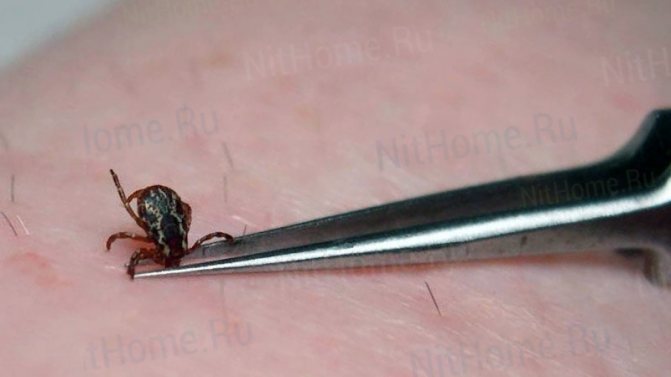
Curved tweezers are suitable as long as the tick is not sufficiently saturated with blood and its size is too small. You can get a tick using this method by following these steps:
- Grab the bloodsucker at the surface of the skin without squeezing its body;
- Hold the tweezers parallel to the bite site;
- Gently pull up and at the same time begin to slowly unscrew the pest (you can rotate it in any direction, the main thing is not to change direction);
- Do not pull out the tick, but gradually unscrew it along with the head.
You can watch the tick removal process in the video.
Removing a tick with your fingers
This method does not require additional equipment, but is the least acceptable: it often leads to damage to the pest’s body. You can use it yourself to pull the blood-sucking substance out of the body only as a last resort. How to properly remove an attached tick from a person without special equipment:
- Wash your hands, wrap your thumb and index finger with a piece of gauze or bandage;
- Carefully grab the insect as close to the skin as possible: grasp the junction of the parasite’s body with the head;
- Hold the arthropod perpendicular to the body;
- Gradually pull out the tick with slow rotational movements in any direction until completely removed;
- After removal, treat the bite site on the body with an antiseptic.
Pulling a loop from a thread
In the absence of special tools, you can pull out the pest with a thread. It's not easy to do this on your own.
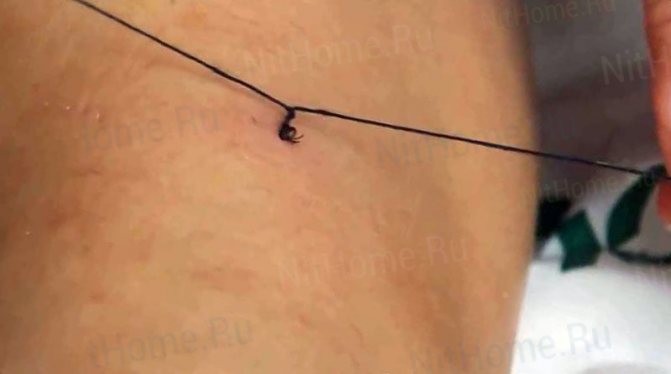
You need to tightly grasp the small body with a loop and, twisting it, pull it out. A quick careless jerk will cause it to rupture. How to remove a tick from a person at home using a thread:
- At home, find and prepare a strong and not very thin thread;
- A loop is made around the pest’s body, close to the proboscis;
- Gently and tightly tighten the thread around the insect's body;
- Pull out with light rocking movements, gradually pulling up;
- It is necessary to pull with stops.
Video on how to twist a tick with a thread
A visual video of how an ordinary person twists a tick out of a child’s skin with a thread will also help.
How to remove a tick with a syringe

After using this method, a small bruise may form on the skin, but it goes away quickly. How can you safely remove a tick using this method? To do this you will need a syringe (insulin or any small volume) and a sharp knife:
- Prepare the syringe: use a knife to evenly cut off the part with the needle;
- Press the resulting instrument tightly around the blood sucker;
- Use the plunger of the syringe to pump out the air: the resulting vacuum will push the small arachnid out of the wound;
- Remove the tick from the body.
This method of removing a bloodsucker is not always effective, as this video proves:
Should you use oil to remove ticks?
Many people mistakenly consider oil to be the first aid in removing the voracious insect using home remedies. They fill it with sunflower oil or any other fat. It is naive to hope that in such conditions the pest should remove the proboscis on its own. In fact, the resulting oil film will kill the arthropod. The pest will simply suffocate, but before that, part of the blood sucked from the parasite’s body can get back into the wound. This increases the risk of infection.
What to prepare before removing a tick
To safely get rid of the parasite, you will need:
- Latex or rubber gloves or a regular plastic bag. You need to protect your skin in case you accidentally crush a tick or its saliva gets on you. Through the slightest wound you can get an infection.
- Disinfectant and cotton wool to treat the wound. Alcohol, chlorhexidine, hydrogen peroxide or iodine solution are suitable.
- Tweezers with fine tips, strong thread or a twister. The latter is very convenient to use, but more difficult to find. It is sold mainly in regular and veterinary pharmacies and in online stores. You can easily buy tweezers or threads in household chemical stores and supermarkets. Be sure to pay attention to the tips of the tweezers. They should be thin so as not to crush the tick. Flat and wide ends will not work.
- A jar with a tight lid and a little more cotton wool moistened with water. This is necessary to transport the parasite to the laboratory.
- Warm water and soap. Or at least wet wipes to wipe your hands.
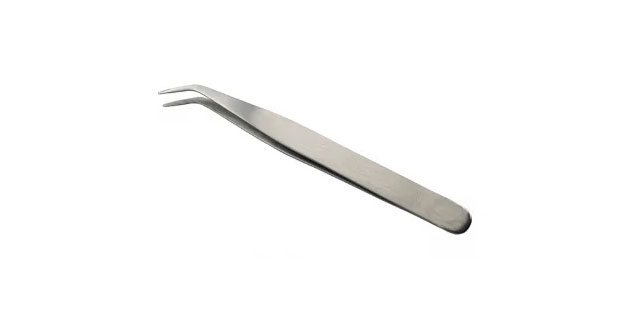
What to buy
- Tweezers with fine tips, 229 rubles →
- HELP pliers twister, 131 rubles →
- RolfСlub ticker, 139 rubles →
Special twisters for pliers
An anti-tick wrench is perhaps the most convenient tool for catching a bloodsucker, since it is made specifically for this purpose. It resembles a lever-wedge device such as a nail puller. The main thing is to place it on the skin so that the body is in a special opening of the teeth, and then carefully unscrew it. The device does not damage the body of the insect, so the threat of infection is minimized. Twisters come in large and small for parasites of different sizes.
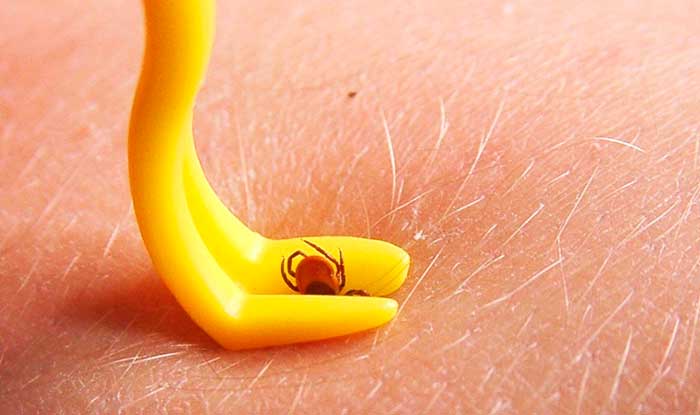
What not to do
Igor Spirin talks about this.
Igor Spirin
General practitioner, deputy chief physician of the Intermed multidisciplinary clinic.
Many folk remedies are actually ineffective and even dangerous. It is forbidden:
- Handle the parasite with your bare hands when removing it from a person or animal. You need to wear gloves or at least a plastic bag.
- Pour oil, gasoline, glue, Vaseline, alcohol, toothpaste, or nail polish onto the tick to suffocate it. While you wait for the parasite to start suffocating and crawl out, a lot of time will pass. And due to lack of air, he can drool into the wound. This will increase Tick bites: What are ticks and how can they be removed? risk of infection.
- Set fire to the tick. This method is just as useless as the previous one. The parasite will not come out, you will simply set it on fire and burn yourself.
- Press on the tick when it is on the skin. This way you will only squeeze the saliva out of it and it will go into the blood.
Symptoms and localization
It is good if the parasitic creature is noticed immediately, but this requires a careful examination of all areas of the body that most likely could have been attacked by an insect.
In most cases, this is:
- groin area;
- skin near the ears;
- armpits;
- inner bend of elbows and knees;
- shoulders and neck;
- any areas where blood vessels come close to the surface of the skin.
But it is not enough to know where an insect can bite; it is important to remove the tick correctly. If such actions are not carried out, and the bite goes unnoticed, then the presence of a bloodsucker can be determined by the following signs:
- inflammation appears on the skin with a dark dot in the center, indicating the presence of the organism;
- later, when saturated with blood, its body swells and becomes almost round.
- at the same time, a burning sensation, soreness and slight itching may be felt;
When an infection occurs, the temperature rises and other unpleasant symptoms may appear.
What to do with a tick
Do not throw it away after removing it. Place the parasite in a jar with wet cotton wool and close the lid tightly. You can store the tick in the refrigerator, but no more than 1-2 days, otherwise the bloodsucker will simply die.
Take the bloodsucker to any clinic where they do a tick test. You can view the nearest laboratories and seroprophylaxis points on the Encephalit.ru website. The analysis is paid, but in public clinics it is usually cheaper than in private ones.
This way you will know whether the tick is infected or not. The result will be known in 1–4 days; ask the laboratory directly for the exact time. If the parasite is contagious, you can quickly begin treatment.

Olga Polyakova
Physician-therapist, senior medical consultant of the Teledoctor-24 service.
The tick must be sent for analysis within two days. The parasite must be alive. Only in this case can the infection be detected.
If it is not possible to check, burn the parasite. And carefully monitor the condition of the bitten person so as not to miss the symptoms of tick-borne encephalitis or borreliosis.
If it was not possible to completely remove the tick
After removing the parasite, the wound must be examined through a magnifying glass to check for the presence of microscopic parts of the mite remaining in it.
If they are still found, then you need to do the following:
- Make sure that the discovered element is part of a removed specimen; its head usually looks like a small black dot.
- Disinfect the bite site.
- Disinfect a needle with a small diameter. It is recommended to treat it with alcohol and then additionally with fire.
- Using a cleaned needle, remove the head or proboscis from the wound in the same way as when removing an ordinary splinter.
If no remaining parts of the parasite were found in the wound, but for some reason there is no complete confidence that the tick was completely removed, then it must be placed in a jar and demonstrated to a specialist who will give all the explanations.
This process should not be delayed, since the head that has not been pulled out may become infected and continue to spread the infection through the blood.
In some cases, jaws may remain in the wound, which are quite difficult to notice, but they are not dangerous. The only thing they can lead to is local inflammation that occurs due to the presence of a foreign element, but it will pass without any additional measures.
When you need to see a doctor urgently
It would be good immediately after you see a tick attached to your body. If you have not done this, then in the following cases you must go to the hospital.
- Within 3–14 days, a rash appeared near the bite. This may be a sign of tick-borne borreliosis. Even if the stains have gone away over time, you are still at risk.
- Flu-like symptoms appeared. Usually these are chills, fever, weakness, muscle and joint pain, and headache. They may indicate tick-borne borreliosis or encephalitis.
- The bite turned red and inflamed.
If there are cases of tick-borne encephalitis in your area, do not wait for the results of a tick test for infection. Immediately contact a seroprophylaxis center (this is a method of preventing infectious diseases) or an infectious disease doctor. It will be necessary to carry out emergency prevention on the first day or at least for three days.
Tatyana Loshkareva
You can find out about outbreaks of tick-borne encephalitis and the epidemiological situation in general on the website of Rospotrebnadzor in your region. Information is in the “Sanitary and epidemiological situation” section.
Why are tick bites dangerous?
Ixodid ticks, which carry various infections, are especially dangerous.
The pathologies they provoke:
- systemic tick-borne borreliosis, which can affect the nervous and cardiovascular systems and cause severe joint diseases;
- encephalitis - depending on the location, leads to meningitis, difficulty breathing, headaches, decreased vision and hearing, in some cases - paralysis, coma and death;
- viral hemorrhagic fever, leading to multiple disorders of internal organs;
- ehrlichiosis, in severe cases, causes neurological disorders, kidney dysfunction, respiratory and heart failure;
- Tick-borne typhus, under unfavorable conditions, can be complicated by encephalitis, eye diseases, and mental disorders.
The majority of cases involving tick attacks on humans are associated with walking without ensuring protection from this parasite.
Advice. You should know that arachnids become most active in the early morning and evening, and in clear weather. They do not like sunlight, heat, high humidity during rain, so at this time they make almost no attempts to bite the victim.
How to prevent a tick bite
When going on a hike or just a walk in the forest, take precautions and no one will bite you.
- Treat clothing, shoes, tents, bags and other equipment with a spray containing 0.5% permethrin. This substance is deadly for ticks. Follow the instructions carefully.
- Apply a repellent containing one of these active ingredients to your body: picardin, diethyltoluamide, oil of lemon eucalyptus. Be sure to read the instructions carefully.
- Avoid places where ticks are most likely to hang out - tall grass and bushes.
- Wear thick clothing with long sleeves. Ankles, waist and wrists should be covered to prevent ticks from crawling into the gap between the body and clothing.
- Inspect your companions' and yours' clothing every couple of hours. If you find a tick, remove it, or better yet, burn it.
- Upon returning home, carefully check all your belongings again. Then dry them in the clothes dryer for 10 minutes or simply hang them to air naturally.
- Also inspect and dry tents, bags, backpacks, and shoes, if possible.
- Take a shower as quickly as possible. If the tick is on the body, but has not yet attached itself, water will wash away the parasite.
What actions are undesirable when bitten?
It is better to remove the blood-sucking parasite using the methods listed above, but there are others that may not be safe for the person himself.
Therefore it is not recommended:
- squeeze out the insect with your hands - most often this leads to damage and the fact that part of it remains in the skin;
- pick the wound with a needle without first carrying out a disinfectant procedure for the bite and the instrument;
- when removing, act quickly, jerkily, which leads to the tearing off of the tick's body;
- Do not apply a burning cigarette to the area, as this leads to additional injury to the epidermis in the form of a burn;
- products such as gasoline, turpentine, vinegar also produce a negative chemical effect on the skin layers, which is undesirable, especially since such methods may not give a positive result.
For a person with such a problem, the best option is to extract a live insect, knowing its characteristics and habits, but it is best to follow measures to prevent attacks by the parasite.
What to do after this
After you have succeeded in removing the tick with a syringe or another method, the bite site must be thoroughly treated with an antiseptic, iodine, alcohol or hydrogen peroxide. You should not destroy the insect after it has been removed from the body.
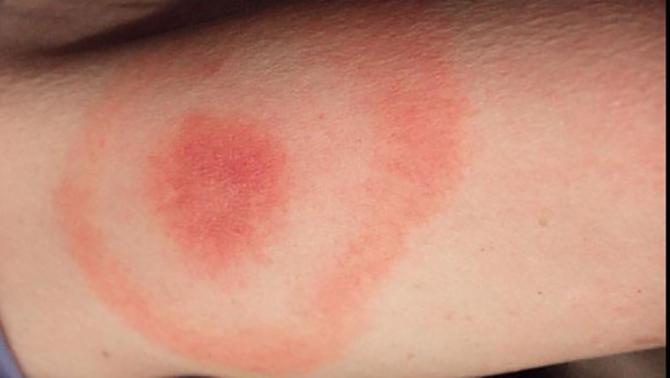
It is advisable to submit it for research to be sure that this individual did not have any dangerous disease. To do this, the tick is placed in a jar. If a lot of time passes before delivery to the laboratory (up to two days), then you need to put a damp cloth in the jar.
How to prevent yourself from being bitten
To prevent ticks from burrowing into the skin, the following measures must be taken.
- When going to a park or forest, you need to wear clothes that cover almost your entire body. The trousers are tucked into the socks and the sleeve cuffs are buttoned. It is also advisable to cover your head with a hat.
- Before sitting on the grass, you need to lay down a blanket.
- Clothes and body should be inspected periodically. Since the insect moves rather slowly, you can easily shake it off your clothes.
- There are vaccinations against encephalitis, which are given in early spring.
- You can use special repellents that protect against both tick bites and other insects.
Prevention
Since the risk arising from a tick bite is quite high, it is strongly recommended to take a number of preventive measures that will reduce the potential danger:
- When relaxing in nature, use the right clothes: they should be as tight-fitting as possible, a hood or headdress is required, trousers should be tucked into shoes, it is best to wear light-colored clothes for more rapid detection of parasites.
- When relaxing outdoors, periodically inspect for ticks. After returning home, the examination procedure must be entrusted to another person who can examine the most difficult to reach areas, for example, the neck or back.
- Treat the skin with an aerosol with a protective antiparasitic effect , which will prevent a possible attack by ticks.
- Get vaccinated against tick-borne encephalitis, the disease most often transmitted by these parasites. This measure will allow the body to begin producing its own antibodies, preventing the active development of the disease in the event of infection. Today there is a quick vaccination, as well as a standard one, which must be carried out in the fall or winter.



